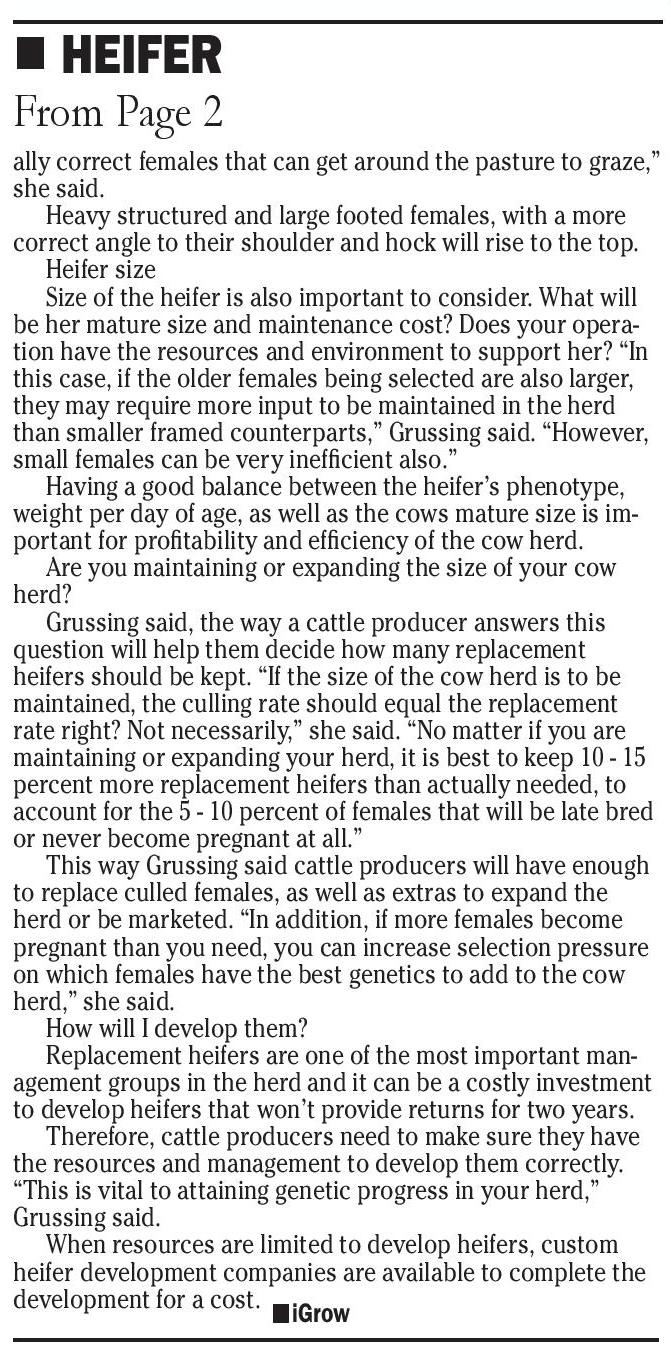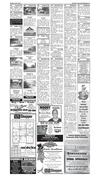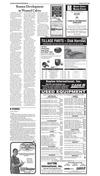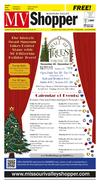111015_YKMV_A5.pdf








shop online at www.missourivalleyshopper.com
November 10, 2015 • Page 5
40 years of SDSU Extension On Exhibit
n heifer
From Page 2
ally correct females that can get around the pasture to graze,”
she said.
Heavy structured and large footed females, with a more
correct angle to their shoulder and hock will rise to the top.
Heifer size
Size of the heifer is also important to consider. What will
be her mature size and maintenance cost? Does your operation have the resources and environment to support her? “In
this case, if the older females being selected are also larger,
they may require more input to be maintained in the herd
than smaller framed counterparts,” Grussing said. “However,
small females can be very inefficient also.”
Having a good balance between the heifer’s phenotype,
weight per day of age, as well as the cows mature size is important for profitability and efficiency of the cow herd.
Are you maintaining or expanding the size of your cow
herd?
Grussing said, the way a cattle producer answers this
question will help them decide how many replacement
heifers should be kept. “If the size of the cow herd is to be
maintained, the culling rate should equal the replacement
rate right? Not necessarily,” she said. “No matter if you are
maintaining or expanding your herd, it is best to keep 10 - 15
percent more replacement heifers than actually needed, to
account for the 5 - 10 percent of females that will be late bred
or never become pregnant at all.”
This way Grussing said cattle producers will have enough
to replace culled females, as well as extras to expand the
herd or be marketed. “In addition, if more females become
pregnant than you need, you can increase selection pressure
on which females have the best genetics to add to the cow
herd,” she said.
How will I develop them?
Replacement heifers are one of the most important management groups in the herd and it can be a costly investment
to develop heifers that won’t provide returns for two years.
Therefore, cattle producers need to make sure they have
www.missourivalleyshopper.com
the resources and management to develop them correctly.
“This is vital to attaining genetic progress in your herd,”
Grussing said.
When resources are limited to develop heifers, custom
heifer development companies are available to complete the
development for a cost.
niGrow
www.missourivalleyshopper.com
South Dakota
www.missourivalleyshopper.com
Farm Stories
Expansion of family run
in numbers.
livestock operations has
According to the USDA
been happening for a while
“average small-farm financial
in the US. The reason is
performance lags well beoftentimes attributed to the
hind that of large farms, sugeconomies of scale which
gesting that production will
give farms greater leverage
continue to shift to larger
with suppliers and clients
operations”. (To read more
and helps them keep up
on this go to the “Farm’s Tipwith inflation. One other
ping Point in South Dakota”
reason that compels farms
iGrow article here).
to expand or relocate is the
According to a 2010
desire for the next generaUSDA report, farms selling
tion to join the operation and less than $100,000 will likely
eventually take over.
continue to disappear and
There is oftentimes a
production shift to larger
transition period before this
farms.
next generation becomes the
Small farms have to
main owner/operator. In adimprove production,
dition, there’s frequently the
increase livestock numbers
need to generate enough net
or relocate to increase their
income to supplement the
likelihood of remaining in
www.missourivalleyshopper.com
older generation’s budget
business.
during retirement.
According to the USDA
When I discuss famERS (2010): “Farmers who
ily farms, I’m talking about
want to make a living from
those operations where the
farming, and who can opermajority of the business is
ate a larger crop operation,
owned by the operator and
have a strong incentive to
his or her relatives. This
expand because larger operais also the USDA’s official
tions, on average, show betdefinition.
ter financial performance”.
In South Dakota, 98
Small South Dakota farm
percent of the livestock
operators who want to live
farms are family owned and
exclusively on their farm inmanaged.
come need to enhance their
By the numbers: the state gross sales. The second apof family farms in South
proach is for one or more of
Dakota
the family members to work
Commercial small farms
elsewhere thus contributing
in the state are disappearto the total family income
ing at a constant rate of 3.5
with off the farm funds.
percent per year.
According to a recent
Bear in mind that these
USDA report “Larger farms
figures constituted 24
have a competitive advanpercent of all 2012 farms
tage over smaller farms in
(31,989) or a loss of 276
most commodities because
farms per year. According to
the average cost of producthe U.S. census of agricultion per unit declines as the
ture, between 2002 and 2012, size of the operation grows
small South Dakota commer(referred to as economies
cial farms, with gross sales
of size)”.There are numerbetween $10,000 and $99,999, ous stories that exemplify
decreased at a constant rate
how farms have faced these
of approximately 3.5 percent
challenges with success.
per year. On the other hand,
One such story is that of the
those farms with a gross inKrause family who farm near
come between $100,000 and
$499,999 have seen only a
n stories,
0.35 percent yearly reduction Page 9
BROOKINGS, S.D. - In
them improve their farm or
1952, photographer and
provide them with advice
journalist, Leland “Lee” Sudon home and family - many
low joined SDSU Extension
South Dakotans have a
as a Visual Aids Specialist.
strong relationship and rich
For the next 38 years he
history with SDSU Extencaptured SDSU Extension
sion.”
serving individuals and
As the outreach arm of
communities across South
our state’s Land Grant, South
Dakota.
Dakota State University,
Celebrating SDSU ExtenSDSU Extension’s vision is
sion’s service to South Dato be “the indispensible outkotans, the exhibit, Through
reach link to people growing
Leland Sudlow’s Lens: 40
South Dakota’s, and the
Years of Extension Service
nation’s, future by providHistory, is on display at the
ing solutions and creating
South Dakota Agricultural
opportunities. We foster
Heritage Museum in Brooklearning communities that
ings now through Feb. 29,
empower citizens to advowww.missourivalleyshopper.com
2015.
cate for sustainable change
“This exhibit brings
and strengthen agriculture,
nearly four decades of SDSU
natural resources, youth,
Extension in South Dakota
families and communities.”
to life,” said Karla Trautman,
Families, farming and
SDSU Extension Associranching practices and comate Director. “Whether it is
munities in South Dakota
through 4-H or relying on
look much different today
SDSU Extension for informathan they did 60 years ago
tion and resources to help
when Sudlow began captur-
www.missourivalleyshopper.com
ing them on film. So does
SDSU Extension. By using
images selected from the collection of more than 80,000,
which Sudlow amassed during his career (1952-1990),
the exhibit clearly demonstrates how SDSU Extension
evolved through the decades
to meet the changing needs
of South Dakotans, explained
Gwen McCausland, Director of the S.D. Agricultural
Heritage Museum.
“We used his work as a
framework to create a visual
history of SDSU Extension
and life in South Dakota,”
McCausland said of the collection, which the Sudlow
family and the SDSU Agricultural Communications
Department donated to the
museum for safe-keeping.
This exhibit is S.D. Agricultural Heritage Museum’s
way of honoring SDSU
Extension, which celebrated
a century of service to South
Dakota communities and
individuals in 2014.
“The great thing about
SDSU Extension is the programs they offer change to
meet the needs of the people
they serve,” McCausland
said. “Extension today is
much different than it was
in the 1950s - but so are the
needs of South Dakotans.”
Black and white still life’s
along with brochures, Sudlow’s camera and a recreated
www.missourivalleyshopper.com
Visit our Web site at
www.missourivalleyshopper.com
Visit our Web site at
www.missourivalleyshopper.com
Visit our Web site at
www.missourivalleyshopper.com
Visit our Web site at
www.missourivalleyshopper.com
www.missourivalleyshopper.com
1950s-era office, introduce
visitors to different times in
South Dakota’s history and
ways SDSU Extension provided them with information:
Cold War days when citizens
needed direction on how
to build a fallout shelter;
guidance on how to use a
microwave, easy meals to
prepare as mother’s entered
the workforce or knowing
how much DEET to spray on
your crops.
“We wanted to preserve
the history my husband
captured, which is why we
gave the images to the Agriculture Heritage Museum,”
explained Adele Sudlow, who
like her deceased husband,
began working for SDSU
Extension in 1952.
Adele served as a Music
Specialist for SDSU Extension, instructing music for
women’s Extension groups,
4-H and other Extension
events. The couple married in 1953. When their
first child was born, Adele
decided to work from home
as a piano teacher. At its
peak, Adele was instructing
as many as 60 students who
would drive from as far away
as Huron to take lessons. At
88, Adele still teaches piano
in her Brookings home.
With more than 80,000
images to sift through, the
Agriculture Heritage Museum staff called upon Adele
to help them identify images.
She in turn, reached out to
Sudlow’s SDSU Extension
friends and colleagues.
“No one I called turned
me down unless they were
out of town, “ Adele said, of
the task which took nearly a
year. The museum also hired
an intern, Corey Korth, an
SDSU Journalism major, to
help with archival research.
The exhibit will be on
display at the Agricultural
Heritage Museum through
February 2016. Like the organization it highlights, the
exhibit is designed to travel
and will be displayed in communities throughout South
Dakota in the coming years.
niGrow
www.missourivalleyshopper.com
www.missourivalleyshopper.com
www.missourivalleyshopper.com www.missourivalleyshopper.com
Visit our Web site at
www.missourivalleyshopper.com
Visit our Web site at
www.missourivalleyshopper.com
Visit our Web site at
www.missourivalleyshopper.com
COUPON - Offer expires 11/30/15
OPEN 11 AM -site at
Visit our Web 10PM
$ 00
www.missourivalleyshopper.com
6 OFF
Family Meal
8 Pc. Chicken, 2 Lg. Sides, 4 Biscuits
Schuurmans Farm Supply
WHEN IT COMES TO GRILLING, TASTE RULES...
GREEN MOUNTAIN GRILLS
HARDWOOD PELLET GRILLS
GRILL YOUR TURKEY
THIS THANKSGIVING
FOR A REAL
FEAST!
$599
EASY AS A PUSH OF A BUTTON SET IT & FORGET IT!
2504 Fox Run Pkwy.
Yankton, SD
“Full Service Farm Equipment”
East Hwy. 50, Yankton, SD
1-800-827-9700 • 605-665-3872
sales@koletzkyimplement.com • www.koletzkyimplement.com
Notice of Petition to
Vacate Section Line
in Mission Hill Township
A Petition was presented before the Mission Hill
Township Board of Supervisors at the Regular meeting
held October 27th, 2015 to Vacate Section Line between
Sections 21&28 of Township T-94-N, R-55-W in Yankton
County.
The Mission Hill Township Board of Supervisors
unanimously voted to vacate said section line and
validation becomes official thirty (30) days after the
second publication provided there is no appeal by law.
George Wathier, Clerk
30480 NE Jim River Road
Mission Hill, SD, 57046
Ph. (605) 589-3909 or Cell (605) 464-1113
5 miles West of Tyndall on Hwys. 50 & 37
www.schuurmansfarmsupply.com
Schuurmans Farm Supply
WINTER IS COMING!
Do you have a garage, shop, calving facility,
working chute or other uses (indoor & outdoor)
for a portable radiant heater?
This is the
heater for you!
VAL-6
DIESEL RADIANT
HEATERS NOW
IN STOCK!
The versatile BLIZZARD POWER PLOW®
hydraulically extends from a compact
straight position to a wide BUCKET
BLADE™ scoop position, and into and
extended, wide-pass straight blade, so
you can push more snow in less time.
Ph. (605) 589-3909 or Cell (605) 464-1113
5 miles West of Tyndall on Hwys. 50 & 37
www.schuurmansfarmsupply.com

























 Previous Page
Previous Page





